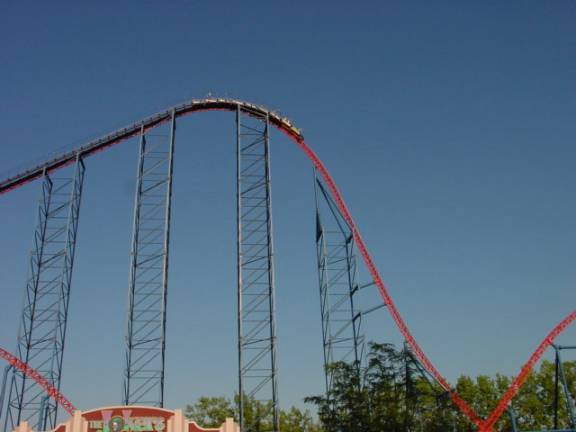The kids finally got to do something they wanted. Six Flags, New England is not as nice as Busch Gardens or Universal Studios. It has a much more industrial feel to it, more the carnival, less the garden.
Roller coasters
The most interesting aspect was the “Superman” roller coaster. It was the most exciting roller coaster I have ever experienced and the only one that I found a little scary. My previous favorite was Apollo’s Chariot in Busch Gardens. Superman has many of the same good attributes: you feel like you will leave the seat, it is very high and very smooth riding. In addition, it has a 221-foot vertical drop and it shoots down at 77 mph. Mariza and I waited an extra fifteen minutes so that we would get to sit in the front car. It was worth it for the thrill of looking straight down before going into the fall and seeing everything coming at you. The ride lasts more than two minutes, which is an unusually long time for one of these things. We had to wait for about an hour to enjoy these two minutes, but it was worth it.
Return of the forest
We drove down along the Massachusetts turnpike and then I –91. Once again I was amazed how much forest there is in this crowded area. According to what I have read, forest covers more of New England today than almost any time in the last millennium. 100 years ago, more than 2/3 of the land was pasture for horses and cows. Before that, Indians regularly set fire to the woods to encourage game species, such as white tailed deer, and to make it easier to move around in the woods. The forests were the heaviest when the Pilgrims landed in 1620. Smallpox and other European diseases had reached the Indian tribes before the Europeans themselves did. Indian populations along the East Coast had declined precipitously a generation before, and with fewer people to burn the forests, the trees had returned. The Pilgrims did not find a virgin land, as they thought, but they did find a land that had been widowed. Their accounts of the thick forests reflect this anomaly. You can tell what had happened by the types of trees they found. Northern hardwoods and hemlock would have replaced the pines, so famously a part of the landscape, if left undisturbed. The white pine forest peaks about a century after the forest regenerates. That is what the Pilgrims found, and that is what they thought was the natural landscape. The settlers set to chopping the trees for their own purposes and did a pretty effective job of destroying them. The forests reached their lowest point about 1920. Since then, the regeneration has been nothing short of remarkable, although the phenomenon is rarely remarked upon. It happens too slowly to be noticed and seems counter intuitive. As suburbs replace farms, it seems like there would be fewer trees, but think about what a farm looks like – not many trees are allowed to grown on a cornfield. A walk in the woods reveals the situation. You come across stone walls that used to divide farm fields and foundations that used to support houses. Now it looks like virgin forest. Once again nature returns.
It is taller than it looks in the picture. Notice the cars on the top about to go down.

